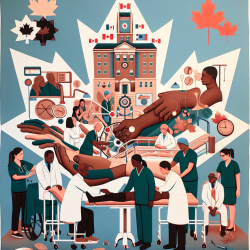Introduction
In the realm of speech-language pathology, the integration of interdisciplinary approaches can significantly enhance therapeutic outcomes. Recent research on a mind-body program developed for obese knee osteoarthritis patients with comorbid depression provides valuable insights that can be adapted to improve therapeutic practices in speech-language pathology, especially for children. This blog explores how the findings from the study titled Development of a mind body program for obese knee osteoarthritis patients with comorbid depression can inform and inspire practitioners in the field.
Understanding the Research
The study highlights the interconnectedness of depression, obesity, and knee osteoarthritis (OA), emphasizing the role of systemic inflammation and pro-inflammatory cytokines in exacerbating these conditions. The research introduces the Relaxation Response Resiliency Program (3RP), adapted as GetActive-OA, which combines mindfulness, adaptive thinking, positive psychology, and healthy living skills to improve physical activity and knee health. Delivered via telehealth, this program aims to reduce inflammation and promote optimal mechanical loading of the cartilage.
Application in Speech-Language Pathology
While the study focuses on physical health, its principles can be translated into speech-language pathology practices, particularly for children. Here are some key takeaways:
- Mind-Body Connection: Understanding the mind-body connection is crucial. Just as in OA, stress and emotional well-being can impact speech and language development. Incorporating mindfulness and relaxation techniques can help children manage anxiety and improve focus during therapy sessions.
- Holistic Approach: The GetActive-OA program's holistic approach, which includes cognitive-behavioral skills and physical activity, can inspire speech-language pathologists to adopt a more comprehensive treatment plan. This might involve integrating physical activities or exercises that promote overall well-being alongside traditional speech therapy techniques.
- Telehealth Delivery: The success of delivering the GetActive-OA program via telehealth underscores the potential of remote therapy sessions. Speech-language pathologists can leverage telehealth to reach children in remote areas, ensuring continuity of care and reducing barriers to access.
Encouraging Further Research
The study's findings encourage further research into the integration of mind-body interventions in speech-language pathology. Practitioners are urged to explore how these techniques can be tailored to meet the unique needs of children with speech and language disorders. By conducting small-scale studies or pilot programs, speech-language pathologists can gather data on the efficacy of these interventions, ultimately contributing to a more robust evidence base.
Conclusion
The intersection of mind-body practices and speech-language pathology offers promising avenues for enhancing therapeutic outcomes. By adopting a holistic approach and leveraging telehealth, practitioners can create more effective and accessible treatment plans for children. As we continue to explore these interdisciplinary connections, the potential for improved child outcomes becomes increasingly apparent.
To read the original research paper, please follow this link: Development of a mind body program for obese knee osteoarthritis patients with comorbid depression.










